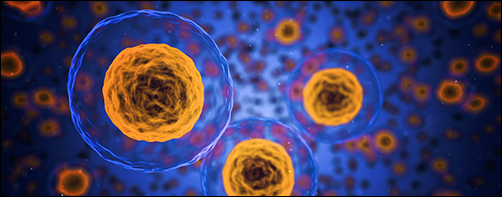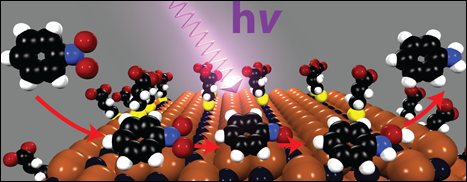PSRC - Research
The Photo-Sciences Research Center (PSRC) focuses on several interwoven research thrusts in order to accomplish its mission of using the energy and interrogating power of light to push back the frontiers of chemistry, physics, and biology.
Photonic Qubits
 The scientific community is on the verge of a revolution in which Quantum Information Science will change the way we live, work, and understand our world. A major challenge is the transport of quantum information from storage units (stationary qubits) to detectors that read the information in a secure way. The photon is the elemental quantum of light. Photons are ideal carriers of quantum information (propagating qubits) because they travel at the speed of light and interact only weakly with their environments. By emitting light only one photon at a time (or pairs of entangled photons), one can encode information in the quantum state of the photon using degrees of freedom such as polarization, momentum, and energy for storage, manipulation and communication, and thereby create photonic qubits.
The scientific community is on the verge of a revolution in which Quantum Information Science will change the way we live, work, and understand our world. A major challenge is the transport of quantum information from storage units (stationary qubits) to detectors that read the information in a secure way. The photon is the elemental quantum of light. Photons are ideal carriers of quantum information (propagating qubits) because they travel at the speed of light and interact only weakly with their environments. By emitting light only one photon at a time (or pairs of entangled photons), one can encode information in the quantum state of the photon using degrees of freedom such as polarization, momentum, and energy for storage, manipulation and communication, and thereby create photonic qubits.
Ultrafast Biology
 It appears that the next frontier in biology is not space, but time. The advances in microscopy that now allow us to resolve objects one hundred times smaller than the wavelength of light have led to the visualization of sub-cellular organelles and single biomolecules in their native environments. These studies have demonstrated the danger in inferring the structures and trajectories of biomolecules from spatially averaged ensemble measurements. The same danger is inherent in drawing a molecular-level picture of a biological system from time-averaged measurements. So many known biological functions – and undoubtedly a much larger number of as-yet unrecognized processes – are performed by, gated by, or otherwise linked to the motions of small molecules, ions, and protein residues that change geometry or diffuse over biologically relevant distances in nanoseconds, a timescale readily accessible by optical methods. Due to limitations of the optical probe or the detector (or both), however, nearly all measurements of evolving biological systems record events with millisecond time resolution. These measurements are blind to important nanometer-scale and low-affinity intermolecular interactions. The exciting questions are then: What are we missing? How could the search for pharmacological targets be improved by high-time resolution measurements of evolving biological systems?
It appears that the next frontier in biology is not space, but time. The advances in microscopy that now allow us to resolve objects one hundred times smaller than the wavelength of light have led to the visualization of sub-cellular organelles and single biomolecules in their native environments. These studies have demonstrated the danger in inferring the structures and trajectories of biomolecules from spatially averaged ensemble measurements. The same danger is inherent in drawing a molecular-level picture of a biological system from time-averaged measurements. So many known biological functions – and undoubtedly a much larger number of as-yet unrecognized processes – are performed by, gated by, or otherwise linked to the motions of small molecules, ions, and protein residues that change geometry or diffuse over biologically relevant distances in nanoseconds, a timescale readily accessible by optical methods. Due to limitations of the optical probe or the detector (or both), however, nearly all measurements of evolving biological systems record events with millisecond time resolution. These measurements are blind to important nanometer-scale and low-affinity intermolecular interactions. The exciting questions are then: What are we missing? How could the search for pharmacological targets be improved by high-time resolution measurements of evolving biological systems?
Photocatalysis
 Excited state (non-thermal) chemistry is poised to become a major force in synthetic chemistry. The reactivity and selectivity of photochemical and photocatalytic reactions will soon be controlled, not only by taking the reacting molecules out of electronic equilibrium, but also by creating new system–environment interactions to bring the entire system out of thermodynamic equilibrium. This perturbation could be achieved by using well-timed light pulse patterns, coupling the system to a resonant cavity to create a new polaritonic potential surface, or to a material that responds mechanically or chemically to the reaction, such that a feedback loop amplifies the catalysis. These types of strategies come closer to natural enzymatic-type function.
Excited state (non-thermal) chemistry is poised to become a major force in synthetic chemistry. The reactivity and selectivity of photochemical and photocatalytic reactions will soon be controlled, not only by taking the reacting molecules out of electronic equilibrium, but also by creating new system–environment interactions to bring the entire system out of thermodynamic equilibrium. This perturbation could be achieved by using well-timed light pulse patterns, coupling the system to a resonant cavity to create a new polaritonic potential surface, or to a material that responds mechanically or chemically to the reaction, such that a feedback loop amplifies the catalysis. These types of strategies come closer to natural enzymatic-type function.


